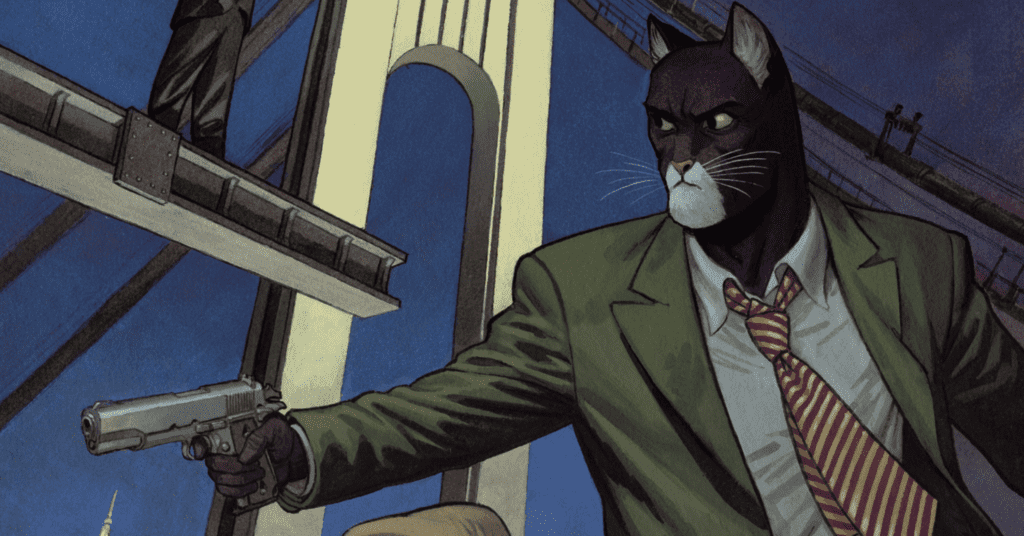Blacksad: They All Fall Down, Part One
Recap
In Blacksad: They All Fall Down, Part One, the titular cat detective and his weasel sidekick Weekly find themselves embroiled in another mystery: one involving murder, mobsters, and mass transit in mid-century Manhattan.
Review
A series that has now been in publication for over twenty years, Blacksad remains a testament to the European album format. While the American comics market demands a twenty or thirty-page issue every month, Blacksad’s more open schedule has led to books that are highly polished, tightly scripted, and artistically uncompromising. Writer Juan Díaz Canales has crafted another twisting page-turner of a mystery with They All Fall Down, Part One, escalating to a fever pitch before leaving readers on the edge of their seats. The volume’s translators Diana Schutz and Brandon Kander have crafted an English-language script that feels almost filmic, capturing all of the suspense and melodrama of noir. While the volume’s final cliffhanger was somewhat dampened for me by my foggy memory of previous volumes, the previous pages did more than enough to leave me on the edge of my seat. The wait for the (as of yet unannounced) next volume feels excruciating.
The time and care Juanjo Guarnido puts into Blacksad’s artwork are unquestionable. Many of the comic’s establishing shots–depicting scenes like Grand Central Station, a bustling protest in Washington Square Park, and a dimly-lit train maintenance facility–are not only gorgeous but achingly precise. There’s a profound sense of nostalgia emanating from the comic’s warm watercolor hues, even as its narrative skewers the systemic injustices of the past.
As the years pass, Blacksad continues showing readers the past through a pair of shattered rose-colored spectacles. Early in They All Fall Down, Part One, Blacksad tells the President of the Transport Workers Union, “I’m not always wild about what I see nowadays, and looking to the past cheers me up”, which Schutz has asserted (in an interview with Comic Watch) is speaking for his creators.
In this particular volume, Canales and Guarnido have chosen to focus on New York’s “master builder” Robert Moses–rendered in Blacksad as a falcon-man named Lewis Solomon–and his lasting impact on the city. While never elected to public office, Moses amassed a great deal of power as a city planner, which he often exerted in disturbing ways. For example, Moses built hundreds of miles of highway which obstructed public transportation in ways that disproportionately affected people of color, guided traffic into Harlem and away from white neighborhoods, and required the destruction of entire (predominantly Latine) neighborhoods. Moses’ comic book counterpart Solomon is more cartoonishly evil, ordering assassinations and working with the mafia, but the spirit of Moses is there in more than name only. While this particular volume of Blacksad focuses less on systemic racism, Canales and Guarnido stress how Moses/Solomon’s desire to pull New York into the future happens at the expense of public parks, public transportation, and the people who build and use them.
Contrasting Guarnido’s precise backgrounds are the comic’s characters: exaggerated, anthropomorphic animals imbued with liveliness by the former Disney animator who has drawn them. In the popular imagination, anthropomorphic animals have traditionally been associated with children’s books like The Wind in the Willows, Frog and Toad, and the Busytown books. However, Blacksad continues to prove how effective such a narrative device can be within fiction for a mature readership. While anthropomorphism has the ability to allow a larger audience to identify with non-human characters, the animal qualities of Blacksad’s characters effectively act to amplify their personalities. Making Solomon a falcon, for example, works to amplify his predatory, ruthless nature. In general, male characters have noticeably diverse body types and expressive animal faces, but many of their female counterparts seem uncannily human. Set apart only by different animal noses and ears, they all share the same pouting lips, large eyes, and hourglass silhouette more often than not. The first volume of Blacksad, was, in retrospect, its least complex: a noir pastiche grounded in Edgar Allan Poe’s idea that “the death [of] a beautiful woman is, unquestionably, the most poetical topic in the world.” While subsequent volumes of Blacksad have greater levels of narrative depth, Guarnido’s way of drawing female characters feels like something of a hold-over. While Guarnido seems to be emulating depictions of women in mid-century media, the result is something objectifying and uncanny. Not just distracting, it feels at odds with Blacksad’s attempts to skewer mid-century misogyny. While the comic certainly depicts a porcupine Peeping Tom that sexually harasses women, Guarnido’s long-term stylistic choice obscures the message. Iris – a llama theatre director – is one of the volume’s few exceptions to the rule and Blacksad is all the better for it. Hopefully, future volumes lean more in her direction, giving female characters more varied and animalistic character designs.
The first volume of Blacksad twenty years ago offered a compelling mystery, but in retrospect feels more like a noir pastiche without much to call its own. In the intervening twenty years, Blacksad has become increasingly complex and engaged with the time its stories take place in. However, the creators continue to show their love of mid-century media on their sleeves through allusions to works like The Maltese Falcon and Edward Hopper’s Nighthawks. Blacksad’s humor and charm go beyond cheeky references and lighten up an otherwise pulse-pounding thriller. People who have followed the series certainly won’t be disappointed, but if you’re new to Blacksad, there’s no better time to start than the present.
Final Thoughts
Blacksad: They All Fall Down, Part One is a gorgeous, twisting page-turner that invites us to peek into New York’s past through a pair of shattered rose-colored glasses.
Blacksad: They All Fall Down, Part One: Murder and Mass Transit in Manhattan
- Writing - 9.5/109.5/10
- Storyline - 9.5/109.5/10
- Art - 9.5/109.5/10
- Color - 10/1010/10
- Cover Art - 10/1010/10
